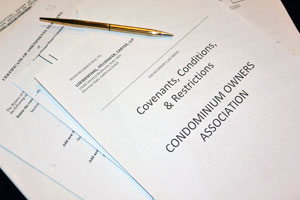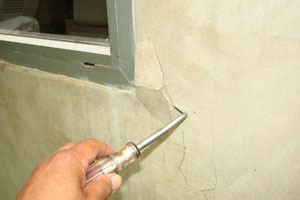LHC Newsletter Vol. 3, No. 5
“Earthquake Insurance: Whether to Drop Coverage or Not Drop Coverage (An Economic Reality Check)”
By: David A. Loewenthal, Esq. and Robert D. Hillshafer, Esq.
In this economic environment, many of our Association clients who currently have earthquake insurance are asking if they are legally obligated to continue to purchase earthquake insurance as part of the Association’s master policy. The immediate answer is “it depends,” because the Association’s governing documents will dictate what the obligation is. However, our experience in representing many Associations at the time of and after the 1994 Northridge Earthquake underscores and reinforces our belief that Association’s should maintain earthquake insurance if economically feasible.
Consideration of potentially dropping earthquake insurance is partially a result of the various economic conditions facing all Homeowner Associations which have forced Boards to explore cost cutting measures. More specifically, assessment collections have dropped, delinquencies have risen, as well as foreclosure activity. Thus, Boards of Directors are faced with the difficulty of attempting to maintain the basic operation of an Association with fewer of the members actually paying their homeowner assessments. Secondarily, as the memories fade regarding the serious and long term ramifications of being an Association without earthquake insurance when a significant event occurs, human nature allows even rational people to look at it as a remote risk.
Notwithstanding the fact that earthquake insurance has been in place for an extended period of time and is a “line item” in the Association’s budget, many Boards are considering whether or not to use the money collected for the earthquake insurance during the year for basic operation versus continuing procurement of earthquake insurance.
STATUTORY REQUIREMENTS
California has no statutory mandate that an Association maintain earthquake insurance as part of its master insurance policy. The only possible mandate to maintain such insurance will be in the Association’s governing documents. Generally, most Association’s governing documents do not require that earthquake insurance be obtained. In some newer Association documents you may see language that states that earthquake insurance is to be either maintained or obtained if it is “economically feasible.” However, such language is very rare in original documents and only slightly more common in restated or amended documents. It has been our practice to propose a mandatory earthquake provision based on economic feasibility when we are requested to draft amendments or restatements. The “insurance” provisions in most CCRs will clearly list what the mandatory minimum coverages that the Board must maintain and unless earthquake is clearly specified, it is not a requirement. If the Association’s governing documents require earthquake insurance then, it must be determined if that duty is limited or based upon economic feasibility.
Even though there may be no statutory obligation or CCR requirement to purchase earthquake insurance, we still believe that earthquake insurance should be obtained and/or maintained if economically feasible. Further, even in the absence of a requirement of member approval, we do not recommend that Board’s unilaterally terminate earthquake insurance, instead recommending that the members be forced to vote for or against maintenance of discretionary earthquake coverage. However, if the membership or the Board decides to eliminate such coverage, the Board is statutorily required to provide notification of this change in coverage or elimination of coverage to the Association’s membership immediately as required by Civil Code Section 1365(f)(1) and (f)(2). If the Board is even contemplating termination of such coverage without membership vote, we strongly urge that Board’s disclose this consideration well in advance of the actual decision and request membership input.
THE PRACTICAL VIEW
There can be no denying that living in California puts us right in the middle of “earthquake country.” Yet, being an alarmist about such a risk is not necessarily beneficial to the Association or its members. What is important is being prudent and thoughtful in evaluating how best to protect the Association and its members. Included in the analysis is the budgetary reality check that all Association’s Boards of Directors must make. Weighing the cost of not insuring against a potential catastrophic event versus the ongoing costs of maintaining coverage are all required. Depending upon the earthquake insurance premium amount, the Board must evaluate paying incrementally for earthquake insurance continuously to avoid the risk of trying to specially assess to pay for repairs of catastrophic damage in the absence of insurance.
BOARD ACTION
As stated above, if the Board is considering dropping existing earthquake insurance coverage, we believe that it is imperative to put that decision to the vote of the membership. This vote should be conducted in such a way that everyone knows the potential impact of such an action. It is our recommendation that the Board maintain earthquake insurance coverage unless the membership votes against that. We believe that it is prudent for the Board to affirmatively support retention of coverage even in the proposition being voted upon. For example, if the issue is not having the available funds to pay the premiums, the proposed matter to be voted on could be phrased as follows “The Board of Directors is inclined to maintain the existing insurance at an annual premium of X unless a majority of a quorum of the membership votes to cancel or non-renew the policy.”
If the issue is whether the Association has the funds to pay premiums due to increases, the issued presented for a vote could be phrased as follows: “The Board of Directors is inclined to maintain earthquake insurance; however, in order to do so will require a special assessment in the amount of X per unit which requires an affirmative vote of a majority of a quorum of the membership pursuant to Civil Code Section 1366.”
In rare instances, a Board may make a decision that the best economic decision for the Association is actually to drop the insurance but they will allow the membership to vote on reversing that decision by stating that “the Board of Directors has decided, as a result of economic considerations, to not renew the Association’s earthquake insurance, unless a majority of a quorum of the membership vote to maintain the insurance.”
There is no statutory duty to obtain membership consent to maintain insurance. That decision is solely within the discretion of the Board. Conversely, a special assessment which is greater than 5% of the gross annual budget, will trigger the need for membership approval under Civil Code Section 1366. Our recommendation about membership voting is to insulate the Board of Directors from claims of negligence or breach of fiduciary duty in terminating coverage by members who are subsequently economically harmed because of the lack of insurance. Of special note concerning such claims, the Association’s liability insurance and D & O policy will generally not cover claims of negligence relating to decisions to purchase or terminate insurance coverage. This risk to the Association and individual directors can likely be eliminated simply by forcing the membership to vote on the issue.
Again, what earthquake insurance coverage comes down to is costs, benefits and potential risk taking. As such, we strongly recommend that any Board that is inclined to cancel or not renew Association earthquake insurance consult with legal counsel and insurance provider or agent. Boards should request written opinions pro and con from both legal counsel and the insurance consultant and should carefully review all policy details, costs and ask the appropriate questions prior to making this significant decision. We believe it to be inevitable that most Associations will eventually face significant expenses arising from an earthquake. Associations will either have to pay premiums on an annual ongoing basis or, make a decision not to pay the incremental premiums, thus risking a future substantial financial hardship on the Association and its members. When an earthquake occurs and the Association is uninsured for the event, the Association and its members must be prepared to potentially pay a massive special assessment to repair the building to a livable standard or face the risk of an uninhabitable building. Unfortunately, these are in fact the events that we have learned from past natural disasters.
Full communication and documentation of insurance issues is critical, as is the disclosure and proper communication about the considerations of maintaining or dropping insurance coverage. In difficult economic times, these decisions become more problematic as every dollar spent by the Association is more heavily scrutinized and second guessing is widespread. However, from a purely Board perspective, a Board cannot be negligent or make a “wrong” decision by maintaining coverage in place or by conditioning the termination of coverage on a majority vote of the membership.
DISASTER/EARTHQUAKE PLANNING AND RECOVERY RESOURCES
Provided here are summary descriptions and web addresses for a variety of earthquake/disaster planning and recovery resources:
The Great Southern California Shake Out – Oct. 15, 2009: http://www.shakeout.org – The second annual, week of special events featuring the largest earthquake drill in U.S. history, organized to inspire Southern California to get ready for the big earthquakes, and to prevent disasters from becoming catastrophes.
Dare to Prepare:
http://www.daretoprepare.org – Earthquake professionals,
business and community leaders, emergency managers, and others have joined together to organize Dare to Prepare, an earthquake readiness campaign to raise earthquake awareness and encourage earthquake readiness in Southern California.
Putting Down Roots in Earthquake Country: http://www.earthquakecountry.info/roots/cover.html – A publication (online link w/PDF download available) of the Southern California Earthquake Center which outlines the 7 steps to preparedness and also provides planning, as well as basic regional seismic history, maps and information.
©2009 by Loewenthal, Hillshafer & Carter, LLP. All rights reserved. Permission is granted to reproduce or transmit in any form any part of this newsletter as long as proper attribution to Loewenthal, Hillshafer & Carter, LLP is given. Due to the rapidly changing nature of the law, information contained in this publication may become outdated. As a result, lawyers and all others using this material must research original sources of authority.


